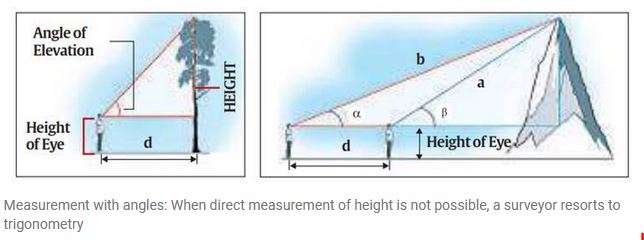Note4Students
From UPSC perspective, the following things are important :
Prelims level: Mt. Everest
Mains level: Himalayan Orogeny

China and Nepal have announced Mount Everest is 0.86 m taller than the 8,848 m accepted globally so far.
Try this PYQ:
Q.When you travel to the Himalayas, you will see the following:
- Deep gorges
- U-turn river courses
- Parallel mountain ranges
- Steep gradients causing land-sliding
Which of the above can be said to be the evidences for the Himalayas being young fold mountains?
(a) 1 and 2 only
(b) 1, 2 and 4 only
(c) 3 and 4 only
(d) 1, 2, 3 and 4
Scaling a mountains’ height

- The basic principle that was used earlier is very simple and uses only trigonometry which most of us are familiar with, or at least can recall.
- There are three sides and three angles in any triangle. If we know any three of these quantities, provided one of them is a side, all the others can be calculated.
- In a right-angled triangle, one of the angles is already known, so if we know any other angle and one of the sides, the others can be found out.
- This principle can be applied for measuring the height of any object that does not offer the convenience of dropping a measuring tape from top to bottom.
Accuracy issues
- For small hills and mountains, whose top can be observed from relatively close distances, this can give quite precise measurements.
- But for Mount Everest and other high mountains, there are some other complications.
- These again arise from the fact that we do not know where the base of the mountain is.
Measuring against sea level
- Generally, for practical purposes, the heights are measured above mean sea level (MSL). Moreover, we need to find the distance to the mountain.
- This is done through a painstaking process called high-precision levelling. Starting from the coastline, we calculate step by step the difference in height, using special instruments.
- This is how we know the height of any city from mean sea level.
Adjusting gravitation anomaly
- But there is one additional problem to be contended with — gravity. Gravity is different in different places. It means that even sea level cannot be considered to be uniform at all places.
- So, the local gravity is also measured to calculate the local sea level. Nowadays sophisticated portable gravitometers are available that can be carried even to mountain peaks.
Technology solutions
- These days GPS is widely used to determine coordinates and heights, even of mountains.
- But, GPS gives precise coordinates of the top of a mountain relative to an ellipsoid which is an imaginary surface mathematically modelled to represent Earth.
- This surface differs from the mean sea level. Similarly, overhead flying planes equipped with laser beams (LiDAR) can also be used to get the coordinates.
How accurate are China/Nepal’s apprehensions?
- Considering that during 1952-1954, when neither GPS and satellite techniques were available nor the sophisticated gravimeters, the task of determining the height of Mount Everest was not easy.
- Nepal and China have said they have measured Mount Everest to be 86 cm higher than the 8,848 m that it was known to be.
- But these have been explained in terms of geological processes that might be altering the height of Everest. The accuracy of the 1954 result has never been questioned.
- Most scientists now believe that the height of Mount Everest is increasing at a very slow rate. This is because of the northward movement of the Indian tectonic plate that is pushing the surface up.
- Big earthquake, like the one that happened in Nepal in 2015, can alter the heights of mountains. Such events have happened in the past.
Get an IAS/IPS ranker as your 1: 1 personal mentor for UPSC 2024
